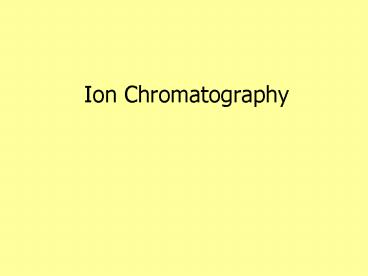Ion Chromatography PowerPoint PPT Presentation
1 / 47
Title: Ion Chromatography
1
Ion Chromatography
2
Ion Exchange
Separation is facilitated by formation of ionic
bonds between charged samples and
chargedcolumn packings
3
Ions
Ions can be characterised as organic, inorganic,
anion or cation and mono or polyvalent
4
Chemical Considerations
- Anion or Cation exchanger
5
Strong vs Weak Exchange Materials
Strong exchangers stay ionised as pH varies
between 2 and 12. Weak exchangers can lose
ionisation as a function of pH.
6
Factors Affecting Ion Exchange Retention
7
Control of Ion exchange by pH
Changing the pH can eliminate the charge of the
columnif the column is weak, or eliminate the
charge on the ion ifion is weak. Either way, the
retention is reduced.
Strong ion - Weak Exchanger
8
Exchange Capacity of Anion Exchanges
Exchange Capacity Number of functional groups
per unit weight of resin
9
Exchange Capacity of Anion Exchanges
pH has no effect on capacity of strong cation
exchanges. Weak cation exchanges change
dramatically with pH.
10
Control of Ion exchange by Ionic Strength
As the concentration of the eluent ion increases,
retention tends to decrease
-
A
Sample Zone
BGE Zone
BGE Zone
11
Control of Ion exchange by Eluent Ion
cations
anions
12
The equilibrium constant
At pHpKa 50 is ionised and 50 is neutral At
pHpKa 1 90 is ionised At pHpKa -1 10 is
ionised
13
Common Acidic Buffers
14
Common Basic Buffers
15
Anion exchange Separation development
Sample Weak or strong? Column weak or
strong? pH ?
16
Anion exchange Separation development
17
Anion exchange Separation development
18
Anion exchange Separation development
19
Anion exchange Separation development
20
Anion exchange Separation development
21
Cation exchange method development
Column Strong Cation Exchange Sample Weak
bases pH acidic (all compounds are ionised)
22
Effect of ionic strength
23
Effect of pH
Compare this separation at pH4.55 and 0.05 in
the previous example. Increasing pH
reducedretention.
24
Effect of Temperature
Increasing temperatureincreases efficiency,
decreases k, and may affect ?. This is due to
improvedmass transfer.
25
UV Detection
- UV detection.
- Direct detection UV transparent eluent eg,
bromide, nitrate, nitrite, thiocyanate, _at_214nm - Indirect Detection UV absorbing
electrolyte.Anions are detected via vacancies
in background absorbance - universal detection
- usually used when other modes of detection are
unavailable. - Very specific
26
Concentration Changes
27
UV Detection
28
Direct UV Detection
29
Indirect UV Detection
30
Indirect UV detection
31
Conductivity Detection
- Ohms law V IR
- conductance, G
- Non - Suppressed
- direct - low conducting eluent - high
conducting analytes - indirect - high conducting eluents - low
conducting analytes
32
Ion Conductances
33
Conductivity Detection
34
Direct Conductivity Detection
35
Waters Ion Analysis Method
Eluent Borate/Gluconate Column IC Pak HR Flow
Rate 1ml/min Injection 50 ul Detection Direct
Conductivity Background 274 uS
36
Indirect Conductivity
37
Conductivity Detection Suppressed
38
Conductivity Detection Suppressed
39
(No Transcript)
40
Membrane Suppressor
41
(No Transcript)
42
Autosuppression
43
Eluent Generation KOH
44
Eluent Generation MSA
45
Why the difference?
46
Separation of Cations
47
Practical Sessions
- Analysis of Inorganic Anions by direct
conductivity.

